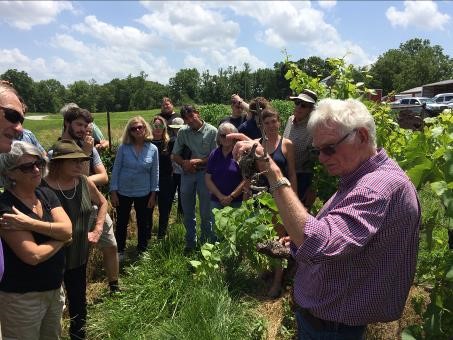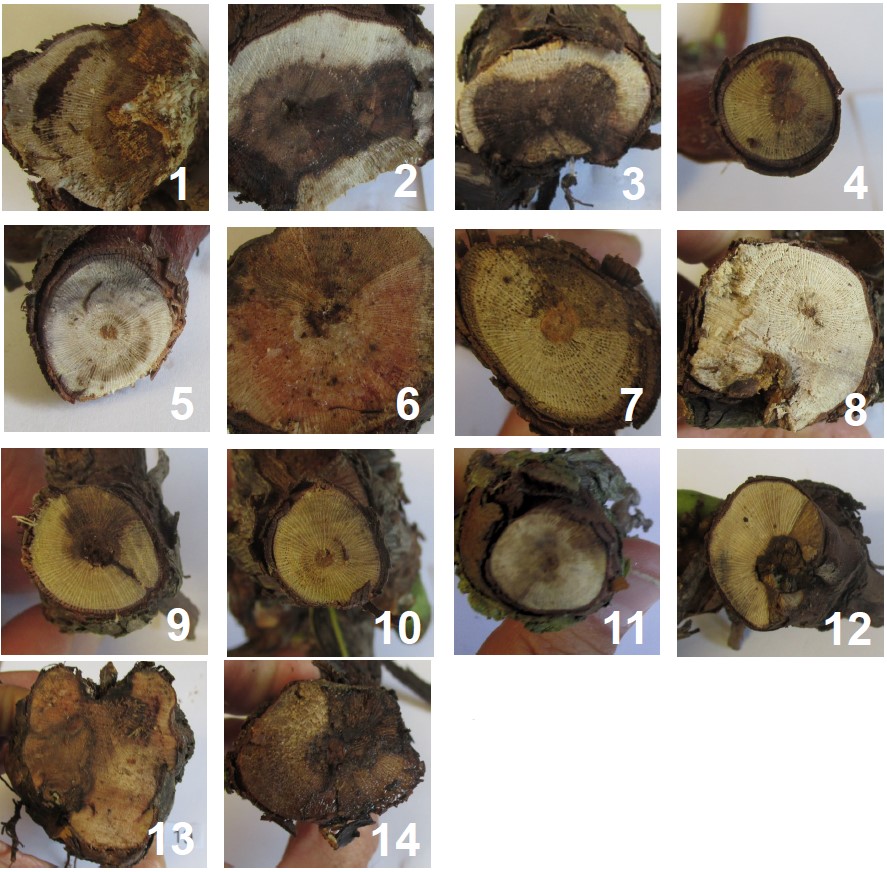Vinews
No. 17 — Aug. 19, 2019
Contents:
- What Have We Learned from Richard Smart's Visit to Missouri in Late June 2019
- Grape Exchange
- Survey of Viruses Found in Grapevine Cultivars in Missouri
- Cumulative Growing Degree Days for the Seven Grape Growing Regions of Missouri from April 1 to Aug. 20, 2018
What Have We Learned from Richard Smart's Visit to Missouri in Late June 2019

During Richard’s three-day visit to Missouri, we had the opportunity to visit a number of vineyard blocks. Richard found the telltale symptoms of trunk disease in all the vineyard blocks visited. Although, symptoms tell us that a problem may be occurring in the vine, to determine which fungal organisms are responsible requires laboratory culturing and a trained diagnostician. The following pages tell the story of what we found in Missouri vineyards.
Materials and Methods
A field survey was conducted in late June of 2019 in mainly bearing vineyards located in Boone, Gasconade and St. Charles counties in Missouri. Grape cultivars sampled included; Chambourcin, Chardonel, Concord, Norton, Valvin muscat, and Vidal blanc. A total of 14 samples were collected from symptomatic grapevines showing dieback of the cordon or stunted shoot growth. Samples were also collected from six wild vines in close proximity to vineyards. In addition, five samples were collected from young vines which included Norton established in 2018, Saperavi established in 2019, and Chardonel plants that were not planted. A sample consisted of either a trunk, cordon, or graft union that was showing trunk disease symptomology (See pictures below). The symptomology expressed in the diseased samples included dark necrotic spots, pie-shaped/wedge cankers, or black streaking. Samples were sent via overnight delivery to TriCal Diagnostics laboratory for culturing and identification.
Results
Thirteen of the 14 samples of mature cultivated grapevines were infected with one or more fungal pathogen (Table 1). The most common fungal pathogen identified was Phaeocremonium spp and Phaeomoniella spp. that cause Esca and Petri disease. Similarly wild grapevines also were infected with Phaeocremonium spp (83%) and Phaeomoniella spp. (33%) (Table 3). Mature cultivated grapevines were also infected with Diaporthe spp. that causes Phomopsis, Diatrypaceae spp. that causes Eutypa, and Botryosphaeriacea spp, causing canker. A previous survey for grapevine trunk diseases in Missouri reported genera in the family Botrysphaeriaceae as being the most prevalent with genera in the Sporocadaceae as being the second most prevalent (Urbez-Torres et al. 2011). Although our sample size was small compared to Urbez-Torres et al 2011, our results suggest that Esca and Petri disease are increasing in Missouri vineyards. Further, Phaeomoniella spp. were the only fungal organism isolated from 50% of the wild grapevines and Phaeomoniella and Phaeocremonium spp. were isolated in 33% of the wild grapevines. No effort was made to identify the species of wild grapevines. Readers should be aware that Missouri has 6 native or naturalized grape species and include Vitis. aestivalis, V. cinerea, V. palmata, V. riparia, V. rupestris and V. vulpina. The increase in Esca is likely the result of climatic changes. Whereas other wine grape growing areas in the Midwestern and Northeastern United States and Quebec, Canada may experience extreme winter cold temperatures that may weaken grapevines and stimulate endophytic pathogens causing trunk disease, Missouri winter temperatures are much warmer in comparison. Esca is likely increasing in Missouri as a result of drought events. Endophytes causing Esca are opportunistic and can be pathogenic when grapevines are under drought stress events (Fischer and Peighami Ashnaei 2019). In the last 10 years, Missouri has experienced some level of drought every year except 2010. The most intense drought occurred in 2012 and impacted more than 35% of Missouri land (USDA accessed 08-20-2019). Young vines mainly were infected with saprophytic fungus except a 2-year-old Norton vine in which Diaporthe ampelina and Pestalotiopsis/Neopestalotiopsis spp. were identified (Table 2).
Literature cited
- Fischer, M. and S. Peighami Ashnaei. 2019. Grapevine, esca complex, and environment: the disease triangle. Phytopathologia Mediterranea 58: 17-37.
- Urbez-Torres, J.S., F. Peduto, R.K. Striegler, K. E. Urrea-Romero, J.C. Rupe, R. D. Cartwright, and W.D. Gubler. 2012. Characterization of fungal pathogens associated with grapevine trunk diseases in Arkansas and Missouri. Fungal Diversity 52:169-189.
- USDA. US Drought Portal. (n.d.). https://www.drought.gov/drought/states/missouri
Table 1. Trunk disease pathogens isolated from samples pictured. Samples collected from mature bearing grapevines in Boone, Gasconade and St. Charles counties on June 26-28, 2019.

| Sample No. | Cultivar | Trunk Disease |
|---|---|---|
| 1 | Chambourcin | Alternaria spp. |
| 2 | Chardonel | Diatrypella spp., Phaeomoniella spp. |
| 3 | Chardonel | Phaeocremonium spp., Phaeomoniella spp. |
| 4 | Concord | Diaporthe neoviticola |
| 5 | Concord | Phaeocremonium spp., Phaeomoniella spp. |
| 6 | Norton | None |
| 7 | Norton | Lasidiplodia theobromae |
| 8 | Norton | Diatrypella verruciformis, Pheaomoniella spp. |
| 9 | Valvin muscat | Diaporthe spp., Neofusicoccum parvum |
| 10 | Valvin muscat | Botrysphaeria dothidea, Diaporthe eres |
| 11 | Valvin muscat | Diaporthe ampelina, Diatrypella spp. |
| 12 | Vidal blanc | Botrysphaeria dothidea, Diatrypella verruciformis, neopestalotiopsis clavispora |
| 13 | Vidal blanc | Phaecremonium spp., Phaeomoniella spp. |
| 14 | Vidal blanc | Alternaria spp., Diatrypella spp. |
Table 2. Trunk disease pathogens isolated from samples pictured. Samples collected from young/non-bearing grapevines in Boone, Gasconade and St. Charles County on June 26-28, 2019.

| Sample No. | Cultivar | Trunk Disease Pathogen | Saprophytes |
|---|---|---|---|
| 1 | Norton | None | Bionectria spp., Cladosporium spp., Mortierella spp., Penicillium spp. |
| 2 | Norton | Diaporthe ampelina, Pestalotiopsis / Neopestalotiopsis spp. | Fusarium spp. |
| 3 | Chardonel | Alternaria spp. | Cladosporium spp., Epicoccum spp., Penicillium spp. |
| 4 | Chardonel | None | Bionectria spp., Penicillium spp. |
| 5 | Saperavi | None | Penicillium spp. |
Table 3. Trunk disease pathogens isolated from samples pictured. Samples collected from wild grapevines in Boone and Gasconade County on June 26-28, 2019.

| Sample No. | Cultivar | Trunk Disease Pathogen | Saprophytes |
|---|---|---|---|
| 1 | Wild | Phaeomoniella spp. | None |
| 2 | Wild | Phaeocremonium spp., Phaeomoniella spp. | Bionectria spp., Cladosporium spp., Mortierella spp., Penicillium spp. |
| 3 | Wild | Phaeocremonium spp., Phaeomoniella spp. | None |
| 4 | Wild | Phaeomoniella spp. | None |
| 5 | Wild | Botryosphaeria dothidea | Cladosporium spp., Nigrosposra spp. |
| 6 | Wild | Phaeomoniella spp. | None |
Grape Exchange
Grapes for sale can be found by visiting the Grape Exchange webpage. If you would like to list grapes, for sale please contact Karissa King at kingkari@missouri.edu.
Survey of Viruses Found in Grapevine Cultivars in Missouri
Results from 2017 virus survey of Missouri vineyards is available here.
Cumulative Growing Degree Days for the Seven Grape Growing Regions of Missouri from April 1 to Aug. 19, 2019
| Region | Location by County | Growing Degree Days1 | ||
|---|---|---|---|---|
| 2019 | 2018 | 30-year Average | ||
| Augusta | St. Charles | 2721 | 2877 | 2687 |
| Hermann | Gasconade | 2631 | 2762 | 2567 |
| Ozark Highland | Phelps | 2806 | 3010 | 2760 |
| Ozark Mountain | Lawrence | 2746 | 2967 | 2710 |
| Southeast | Ste. Genevieve | 2781 | 2898 | 2777 |
| Central |
Boone | 2720 | 2928 | 2631 |
| Western | Ray | 2579 | 2818 | 2587 |
1 Growing degree days at base 50 from April 1 to Aug. 19, 2019. Data compiled from Useful and Useable at https://mygeohub.org/groups/u2u/tools. Click on link below to determine growing degree days in your area.
To determine the number of growing degree days accumulated in your area since April 1, use this tool.